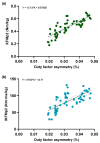Gait Asymmetry and Post-Traumatic Osteoarthritis Following Anterior Cruciate Ligament Rupture: A Preliminary Study
- PMID: 40001975
- PMCID: PMC11851828
- DOI: 10.3390/biology14020208
Gait Asymmetry and Post-Traumatic Osteoarthritis Following Anterior Cruciate Ligament Rupture: A Preliminary Study
Abstract
Knee post-traumatic osteoarthritis (PTOA) often develops in younger populations following anterior cruciate ligament (ACL) rupture, accounting for 12% of all symptomatic osteoarthritis (OA). The current literature implicates gait asymmetry in late-stage knee OA progression; however, early-knee PTOA development involvement is ill defined. This study explored gait asymmetry involvement in early-stage knee PTOA following ACL ruptures. Gait asymmetry, measured as asymmetry in duty factor (relative contact time), and joint loading data were collected, using infrared-camera motion capture and Kistler force plates for participants exhibiting either historical ACL ruptures (ACL+; n = 4) or no previous joint trauma (ACL-; n = 11). Joint loading measures included external knee adduction moment (EKAM) and external knee flexion moment (KFM), early (peak 1; EKAMp1 and KFMp1) and late (peak 2; EKAMp2 and KFMp2), stance peaks (Nm/kg), and respective time integrals (Nm·ms/kg; iEKAMp1, iEKAMp2, iKFMp1, and iKFMp2). ACL+ exhibited greater asymmetrical duty factor (78% difference) and greater joint load differences: EKAMp1 (26%), EKAMp2 (49%), KFMp1 (37%), iKFMp1 (44%), and iKFMp2 (60%). Significant relationships were found between duty factor asymmetry and both KFMp2 (R2 = 0.665) and iKFMp2 (R2 = 0.504). These preliminary data suggest gait asymmetry-induced joint loading may contribute to knee PTOA progression, but further research with increased sample sizes and the quantitative assessment of cartilage status is required.
Keywords: anterior cruciate ligament (ACL); duty factor; external knee adduction moment (EKAM); gait asymmetry; knee flexion moment (KFM); post-traumatic osteoarthritis (PTOA).
Conflict of interest statement
The authors declare no conflicts of interest. Further, the project funders had no role in the design of the study; in the collection, analyses, or interpretation of data; in the writing of the manuscript; or in the decision to publish the results.
Figures



References
-
- Mercurio M., Cerciello S., Corona K., Guerra G., Simonetta R., Familiari F., Galasso O., Gasparini G. Factors Associated With a Successful Return to Performance After Anterior Cruciate Ligament Reconstruction: A Multiparametric Evaluation in Soccer Players. Orthop. J. Sports Med. 2024;12:23259671241275663. doi: 10.1177/23259671241275663. - DOI - PMC - PubMed
Grants and funding
LinkOut - more resources
Full Text Sources

